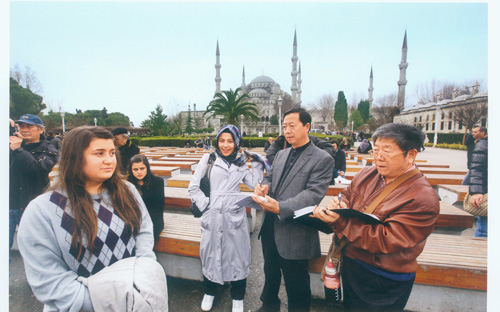|
 |
|
STAND-UP ARTIST: Wang Shengli (right) sketches a Turkish woman at the Blue Mosque in Istanbul in 2011 (COURTESY OF WANG SHENGLI) |
Wang never missed an opportunity to make on-the-spot sketches in Turkey's spiritual capital, and accumulated a treasure trove of material which he said will inform his future work. During his time in the city, he went through three canvases and compiled dozens of sketches, including portraits of local people and landscapes, far exceeding the volume of work he completed in other cities during the tour.
"The Blue Mosque impressed me most. It is a landmark of Istanbul and a gorgeous religious site. The architecture is fantastic and it also looks amazing lit up at night. The interior is decorated with thousands of blue and white tiles featuring Ottoman designs. I fell in love with it, and many of my works were created using the mosque as a background," Wang said.
After returning to China, he often recommended Turkey in his professional and personal circles, especially fellow artists.
"Turkey is a bridge connecting Asia and Europe, both geographically and culturally, and it was an important stop along the ancient Silk Road," Wang said.
Cultural osmosis
The intrepid band of painters set out from Xi'an, capital of northwest China's Shaanxi Province. The city, which was once the capital of China during the Tang Dynasty (618-907) when it was called Chang'an, is widely believed to be one of the eastern endpoints of the ancient Silk Road. The remnants of a Xi'an market dating back to the Tang Dynasty have been discovered in recent years. Archaeological research shows that the market, called the West Market in the Tang Dynasty, was an international commercial and cultural center at that time.
A pottery figurine unearthed from the site wears a gown designed in the West Asian style, demonstrating that clothing during the Tang Dynasty was influenced by West Asian countries. Historical books claim that merchants from Iran and Turkey came to the market to sell spices or vegetable seeds native to their countries and brought Chinese silk and tea back with them on the return trip.
"This is why we made Xi'an the starting point of our journey to revisit the Silk Road and record the past and present of the ancient route through our works," said Wang, a native of the city. "With regard to the creative themes we explored, some of the works touched upon ancient legends, while some reflected the current situation along the Silk Road. Others showed the fruits of cultural and economic interaction between China and countries along the route."
"Cultural exchanges among countries will boost mutual understanding and the development of the countries in question, and this was manifest in the prosperity of the Tang Dynasty, a very open period in China's history in terms of international communication. We hope the close ties forged in ancient times could be renewed and deepened over time," he said.
During his trip to Istanbul, Wang met many Chinese people living there. "I can see that they are living happily in Turkey," Wang said. "I also hope more and more Turkish people could come to China, whether to live or just for a visit."
The artistic tour that Wang participated in was jointly planned and operated by the Xi'an Academy of Fine Arts and Da Tang Xi Shi Cultural Industry Investment Group Co. Ltd., a Xi'an-based company that has invested in a cultural project to restore and protect the relics gleaned from the original site of the Tang-era West Market.
Since November 2010, altogether five such artistically themed tours along the Silk Road have been organized with involvement of a total of nearly 100 Chinese artists. They have visited more than 40 historical cities in 10 countries. The works that resulted from the tours have been exhibited in China, Turkey and some other countries along the route. A painting collection recording the artistic journeys of discovery was published in August 2014.
Copyedited by Eric Daly
Comments to zanjifang@bjreview.com | 